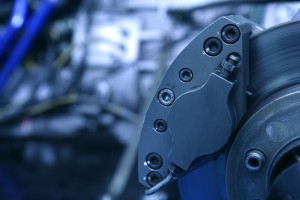Brakes Explained
At AAMCO Minnesota our mission is to fix and maintain your car – from transmissions to electrical systems, oil changes to mufflers. We do it all so you don’t have to. One of our specialties is brakes.
What it Takes to Stop Your Car
Everyone knows that brakevis stop your car. But have you ever wondered what it takes to bring your car to a smooth, safe stop just by pushing the brake pedal? There are three principles of braking – leverage, hydraulics, and friction – that encompass the eight basic steps of how your car’s brakes work wonders every time you step on the brake pedal.
Leverage
Your car’s brakes use leverage. The brake pedal is designed to act as a lever in order to magnify the force from your leg before it is transmitted to the brake fluid. When you press on the brake pedal the system transmits and multiplies the force to the wheels using friction. The tires transmit that friction force to the road, which results in your car slowing down. So, with all that leverage, if you stomp on the brake pedal, the whole process happens very quickly and you end up leaving rubber on the road – and risk going into a skid and losing control. Fortunately, modern brake systems have anti-lock mechanisms that pump the brakes faster than any human could and help you maintain control; but skid marks and damage to your tires can still happen.
Hydraulics
A car’s brake system uses hydraulics. Force applied from the pedal pushes a piston into the master cylinder, forcing brake fluid through a pipe. Fluid pressure is distributed evenly throughout the system to the four wheels. The brake fluid flows to slave cylinders at each wheel, forcing pistons down the cylinders at the wheels. The cylinders at the brakes on the wheels are larger than the cylinder at the brake pedal, which means the force is multiplied far beyond the original push of your leg.
Friction
Friction is the key product of the car’s brakes. It is the force that does the stopping. The slave cylinder pistons are forced down through the cylinders to close the calipers. This applies the brake pads to the rotors – or discs – attached to the wheel hub. All of this is designed to create friction and slow the wheels.
How Brakes Work in 8 Easy Steps
In eight steps your car’s brakes go through a process of combined leverage, hydraulics, and friction to bring your car to a safe, controlled stop.
- Brake pedal is pushed.
- Piston pushes fluid to master cylinder.
- Master cylinder pushes fluid to slave cylinders.
- Slave cylinders fill and push pistons out.
- Pistons push calipers with brake pads.
- Brake pads grip rotors (discs) attached to wheels.
- Friction between brake pads and rotors slows wheels.
- Car slows down and stops.
The combined pressure, or force, of the slave pistons is greater than that of the piston in the master cylinder. The master piston only has to move a few inches in order to push the slave pistons a fraction of an inch. This whole system creates a lot of force – enough to stop an entire car – even though all the driver has to do is push a pedal.
AAMCO Minnesota for Brake Service and Repairs
Now that you’ve got the basics down, did you know the front brakes do more work in stopping your car than the rear brakes? This is due to simple physics – when you brake, the weight of the car shifts forward. Many cars have disc brakes on the front and drum brakes on the rear because disc brakes are more efficient than drum brakes. Four-wheel disc brakes are usually found on high performance and some AWD drive cars. Whatever you drive, you can count on AAMCO to service and repair your brakes so your car is safe and reliable. If you have questions about your car’s brakes, road readiness, or about car repair and maintenance, AAMCO Minnesota can help. Come to AAMCO Minnesota for a Multi Point Vehicle Courtesy Check for your transmission and related systems. We’ll winterize your car and get you ready for the cold, snowy winter driving months ahead. We can handle all your scheduled car maintenance and repairs, from brakes to factory recommended maintenance.
Other Articles About Car Maintenance & Repair
Checklist for Preparing Your Car for Winter
Take the Fear Out of Transmission Repair
. We’re the transmission experts with over 50 years of experience rebuilding and replacing transmissions, and all their 800 pieces. We’ve fixed over 40 million transmissions – way more than our competitors. And we offer a lifetime warranty.  Because we have the skill to fix an 800-piece transmission, we can easily fix the rest of your car – brakes, shocks, mufflers, even your engine. Lots of things can make your engine light come on. Today it can be hard to tell what’s wrong with your car, especially if it’s your transmission. Our technicians are trained to keep up with the complex engineering of today’s cars. So, next time something goes wrong with your transmission or any other part of your car, bring it to your local AAMCO.
Because we have the skill to fix an 800-piece transmission, we can easily fix the rest of your car – brakes, shocks, mufflers, even your engine. Lots of things can make your engine light come on. Today it can be hard to tell what’s wrong with your car, especially if it’s your transmission. Our technicians are trained to keep up with the complex engineering of today’s cars. So, next time something goes wrong with your transmission or any other part of your car, bring it to your local AAMCO.

